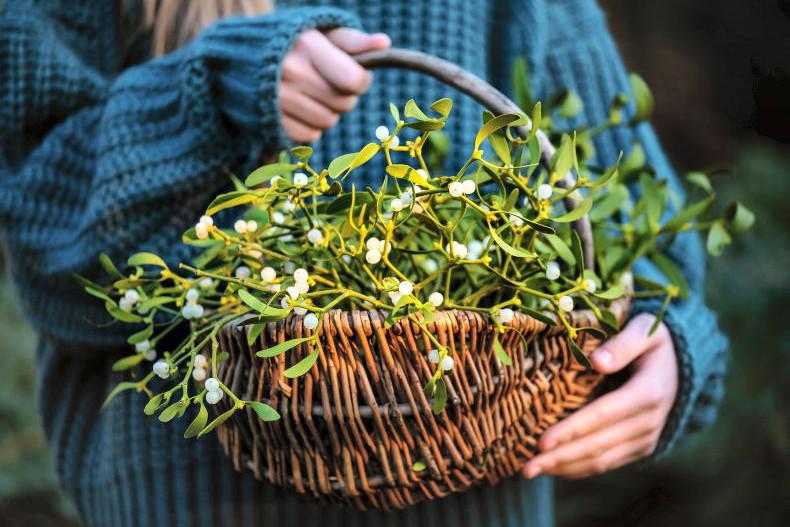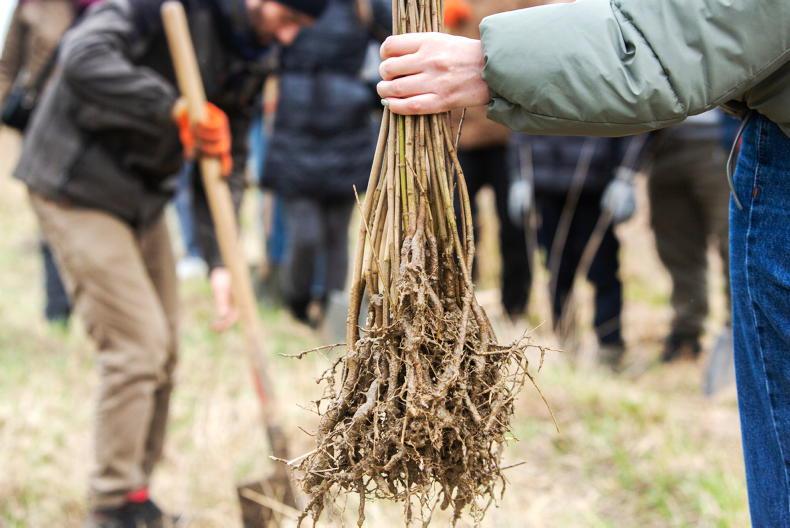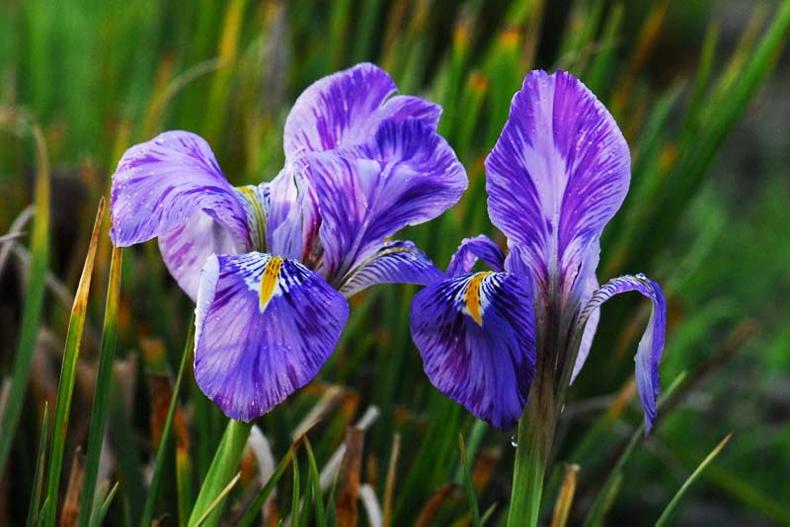Name: Caryopteris, blue mist, bluebeard and blue spirea.
Of the common names, blue spirea is probably the best because it describes the plant quite well. Those familiar with spirea will find it an easy enough leap to see the size, shape and growth habit of the plant. It also looks somewhat like a low-growing ceanothus. Then again, blue mist also has its attractions as the plant has a misty quality in flower. In general, the botanical name is used as a common name, namely Caryopteris.
Botanical name: The botanical name. Caryopteris has a nice ring to it and is not difficult to remember. The word caryopteris is composed of two Greek words: caryos which means ‘a grain’ or ‘a seed’ and pteron, which means ‘a wing’ and the two words together mean winged seeds, a feature of this plant in its natural setting (though not in the cooler climate of Ireland). Many of the garden varieties have been bred as hybrids, notably by A. Simmonds in the town of Clandon, Surrey, England.
Family name: Caryopteris is part of the verbena family, the Verbenaceae. This family of shrubs and perennial flowers is represented in gardens, mainly by the hybrid verbena used widely in hanging baskets, containers and the front of flower beds. It is also represented, especially in recent years, by the purple top or the Buenos Aires verbena, Verbena bonariensis, which has become very popular. The purple top flowers are noticeably similar to those of the caryopteris.
Garden value
Blue is an invaluable colour in the garden at this time of year when there are so many shades of yellow, orange and red. Even the smallest touch of blue here and there is enough to offer a contrast with the autumn colours, and heighten them in the process. Caryopteris gives intensely blue flowers in August and September.
Caryopteris is capable of growing to a bit over one metre tall and somewhat more than that in width. Quite often, it is treated as a pruned shrub, cut back hard in spring each year or every couple of years. When cut back, the plant is kept to a smaller, neater size and the new shoots are more upright.
These spikes carry clusters of small blue flowers in the angles of the leaves along the stems. The flowers have a pin-cushion appearance because of spidery protruding stamens. Although it has a nettle-like appearance to the foliage, a feature of verbena species, they are not related to nettles.
Growing verbena
Mostly the flowers are of an intense purple-blue. Some are lighter and others darker and there are several named varieties. ‘Kew Blue’ is a popular variety with deep blue flowers over grey-green leaves. ‘Heavenly Blue’ is upright with rich blue flowers with a purple tinge. ‘Dark Knight’ has very dark blue flowers over silver-grey foliage. ‘Arthur Simmonds’ has grey-green leaves, silver underneath and rich blue flowers. There is a lovely dark purple-blue called ‘First Choice’.
There are some golden-leaved and variegated varieties too. Apart from ‘Worcester Gold’, the yellow leaves of which make a good contrast, these are wishy-washy. Caryopteris also looks well with grey-leaved plants and can be used to enliven lavender and other greys after these have finished flowering.
The stems of caryopteris are spindly and it is not a very woody shrub. By cutting it back in spring, it becomes almost a herbaceous perennial. It should be set out where its late summer and early autumn blue will be most effective. It is easy to grow in any ordinary soil that is well drained, but not too dry, and it likes a sheltered spot in sunshine to flower best.
Kitchen garden: Pumpkin time
There are three groups of pumpkin relatives: summer squashes and marrows, winter squashes and pumpkins and ornamental gourds. The summer squashes and marrows (or courgettes) are used as immature fruits during the summer months. The winter squashes and pumpkins form a hard skin and can be stored as winter vegetables. And the gourds, also hard-skinned, are mostly used for decorative purposes.
All kinds are related and are members of the cucumber family. None of them is able to withstand frost and the first frost of the season melts the leaves. The fruits are better able to withstand frost but they eventually succumb too, and pumpkins and winter squashes must be stored in a frost-free shed.
They are all easy to grow in much the same way. Most kinds are big plants, a pumpkin plant can easily cover twenty square metres, and this can be too big for a small garden. But if space is available, they are fun to grow, especially for children, who can see the pumpkins grow fast in late summer.
Seeds of pumpkins, squashes and marrows can be sown indoors on a kitchen window sill in early May. Harden off for a week by placing the pots outdoors by day and bringing in at night. Plant out the little plants in early to mid-June in good rich soil in a sunny spot.
Sometimes the plants can be slow to start if the weather is cool. Eventually, strong shoots grow out and these can be let go or have the tips pinched out when they are one metre long. Flowers will be produced, male and female. There might be no sign of fruit setting, but this will happen when the plant is ready. Take, pumpkins into a greenhouse or warm place to develop their colour before they are needed.
This week's reminders
Trees, shrubs & roses
Young trees and shrubs struggled a little during stop/start weather in summer and could be given a liquid feed for a late-season boost to make growth as late as possible for winter reserves. Spells of cold winds have held back growth and many trees are still showing signs of damage from harsh winds in early summer and dry conditions deep in the soil.
Flowers
It might be possible to get another month out of hanging baskets by giving a late liquid feed now. Hardy annual flowers, such as calendula and California poppy can be sown now. Buy and plant spring bulbs as soon as possible to encourage rooting immediately. Bulbs that get well established early are likely to grow on better for future years.
Fruit, vegetables & herbs
If vegetables have gone over, pull them up and compost them, but not if they have root diseases, such as white rot of onion. It is time for planting spring cabbage which benefits from making root growth while there is still a little heat in the ground. Lift potatoes before small underground slugs become more active, and the soil becomes sticky for lifting.
Lawns
Keep on mowing as necessary — there is a second peak of grass growth at this time in most years and it thickens up the grass sward before winter. Apply autumn lawn
fertiliser or a low nitrogen, high potash product to strengthen grass before winter and increase soil
fertility for the following year.
Greenhouse & House plants
Greenhouse tomatoes have been affected by dull weather and cool nights, but can be left on the plant for a few more weeks. Be careful
not to over-water from now on. Water should be given as needed and soil and compost should be just moist, but not wet. Ventilate on dry, breezy days to air out the greenhouse.
Read more
Gardening with Gerry: Autumn beauty
Gardening: I'm walking on sunshine
Name: Caryopteris, blue mist, bluebeard and blue spirea.
Of the common names, blue spirea is probably the best because it describes the plant quite well. Those familiar with spirea will find it an easy enough leap to see the size, shape and growth habit of the plant. It also looks somewhat like a low-growing ceanothus. Then again, blue mist also has its attractions as the plant has a misty quality in flower. In general, the botanical name is used as a common name, namely Caryopteris.
Botanical name: The botanical name. Caryopteris has a nice ring to it and is not difficult to remember. The word caryopteris is composed of two Greek words: caryos which means ‘a grain’ or ‘a seed’ and pteron, which means ‘a wing’ and the two words together mean winged seeds, a feature of this plant in its natural setting (though not in the cooler climate of Ireland). Many of the garden varieties have been bred as hybrids, notably by A. Simmonds in the town of Clandon, Surrey, England.
Family name: Caryopteris is part of the verbena family, the Verbenaceae. This family of shrubs and perennial flowers is represented in gardens, mainly by the hybrid verbena used widely in hanging baskets, containers and the front of flower beds. It is also represented, especially in recent years, by the purple top or the Buenos Aires verbena, Verbena bonariensis, which has become very popular. The purple top flowers are noticeably similar to those of the caryopteris.
Garden value
Blue is an invaluable colour in the garden at this time of year when there are so many shades of yellow, orange and red. Even the smallest touch of blue here and there is enough to offer a contrast with the autumn colours, and heighten them in the process. Caryopteris gives intensely blue flowers in August and September.
Caryopteris is capable of growing to a bit over one metre tall and somewhat more than that in width. Quite often, it is treated as a pruned shrub, cut back hard in spring each year or every couple of years. When cut back, the plant is kept to a smaller, neater size and the new shoots are more upright.
These spikes carry clusters of small blue flowers in the angles of the leaves along the stems. The flowers have a pin-cushion appearance because of spidery protruding stamens. Although it has a nettle-like appearance to the foliage, a feature of verbena species, they are not related to nettles.
Growing verbena
Mostly the flowers are of an intense purple-blue. Some are lighter and others darker and there are several named varieties. ‘Kew Blue’ is a popular variety with deep blue flowers over grey-green leaves. ‘Heavenly Blue’ is upright with rich blue flowers with a purple tinge. ‘Dark Knight’ has very dark blue flowers over silver-grey foliage. ‘Arthur Simmonds’ has grey-green leaves, silver underneath and rich blue flowers. There is a lovely dark purple-blue called ‘First Choice’.
There are some golden-leaved and variegated varieties too. Apart from ‘Worcester Gold’, the yellow leaves of which make a good contrast, these are wishy-washy. Caryopteris also looks well with grey-leaved plants and can be used to enliven lavender and other greys after these have finished flowering.
The stems of caryopteris are spindly and it is not a very woody shrub. By cutting it back in spring, it becomes almost a herbaceous perennial. It should be set out where its late summer and early autumn blue will be most effective. It is easy to grow in any ordinary soil that is well drained, but not too dry, and it likes a sheltered spot in sunshine to flower best.
Kitchen garden: Pumpkin time
There are three groups of pumpkin relatives: summer squashes and marrows, winter squashes and pumpkins and ornamental gourds. The summer squashes and marrows (or courgettes) are used as immature fruits during the summer months. The winter squashes and pumpkins form a hard skin and can be stored as winter vegetables. And the gourds, also hard-skinned, are mostly used for decorative purposes.
All kinds are related and are members of the cucumber family. None of them is able to withstand frost and the first frost of the season melts the leaves. The fruits are better able to withstand frost but they eventually succumb too, and pumpkins and winter squashes must be stored in a frost-free shed.
They are all easy to grow in much the same way. Most kinds are big plants, a pumpkin plant can easily cover twenty square metres, and this can be too big for a small garden. But if space is available, they are fun to grow, especially for children, who can see the pumpkins grow fast in late summer.
Seeds of pumpkins, squashes and marrows can be sown indoors on a kitchen window sill in early May. Harden off for a week by placing the pots outdoors by day and bringing in at night. Plant out the little plants in early to mid-June in good rich soil in a sunny spot.
Sometimes the plants can be slow to start if the weather is cool. Eventually, strong shoots grow out and these can be let go or have the tips pinched out when they are one metre long. Flowers will be produced, male and female. There might be no sign of fruit setting, but this will happen when the plant is ready. Take, pumpkins into a greenhouse or warm place to develop their colour before they are needed.
This week's reminders
Trees, shrubs & roses
Young trees and shrubs struggled a little during stop/start weather in summer and could be given a liquid feed for a late-season boost to make growth as late as possible for winter reserves. Spells of cold winds have held back growth and many trees are still showing signs of damage from harsh winds in early summer and dry conditions deep in the soil.
Flowers
It might be possible to get another month out of hanging baskets by giving a late liquid feed now. Hardy annual flowers, such as calendula and California poppy can be sown now. Buy and plant spring bulbs as soon as possible to encourage rooting immediately. Bulbs that get well established early are likely to grow on better for future years.
Fruit, vegetables & herbs
If vegetables have gone over, pull them up and compost them, but not if they have root diseases, such as white rot of onion. It is time for planting spring cabbage which benefits from making root growth while there is still a little heat in the ground. Lift potatoes before small underground slugs become more active, and the soil becomes sticky for lifting.
Lawns
Keep on mowing as necessary — there is a second peak of grass growth at this time in most years and it thickens up the grass sward before winter. Apply autumn lawn
fertiliser or a low nitrogen, high potash product to strengthen grass before winter and increase soil
fertility for the following year.
Greenhouse & House plants
Greenhouse tomatoes have been affected by dull weather and cool nights, but can be left on the plant for a few more weeks. Be careful
not to over-water from now on. Water should be given as needed and soil and compost should be just moist, but not wet. Ventilate on dry, breezy days to air out the greenhouse.
Read more
Gardening with Gerry: Autumn beauty
Gardening: I'm walking on sunshine









SHARING OPTIONS